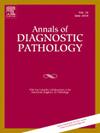Rethinking tissue preservation: A review of non-toxic and environmentally sustainable fixatives
IF 1.4
4区 医学
Q3 PATHOLOGY
引用次数: 0
Abstract
Fixatives are substances used in histopathology to preserve tissue samples by preventing degradation and keeping them structurally intact for microscopic analysis. The common examples include formaldehyde, glutaraldehyde, and alcohols. The widely used fixative, formaldehyde, carries significant health hazards, like respiratory distress, mucosal irritation and carcinogenic effects. Consequently, there is a growing academic impetus to explore natural alternatives to traditional chemical fixatives. Studies were obtained from PubMed database using keywords that covered a wide range of fixatives, including natural, formalin-based, sugar-based, plant-based, and alternative options. Collected data was analyzed and organized into four categories of naturally available fixatives: Aloe vera, Honey, Jaggery, Sugar. 11 studies were included from January 2013 to March 2024. In these, the alternative fixatives has been used for tissue processing. Honey was tested eight times at concentrations of 10 %, 20 %, and 100 %; jaggery six times at 30 % and 100 %; Sugar was used as sugar syrup three times at 20 % and 100 %, as sirka once and as sugarcane vinegar in one study; aloe vera once at 20 %; ethanol twice at 95 %; and formalin nine times at 4 % and 10 %. Compelling evidence demonstrates that natural fixatives can provide tissue preservation on par with formalin, particularly in short-term applications. Although these fixatives are harmless, they come with certain disadvantages Honey has shorter shelf life; Jaggery cause mold formation and produces discoloration of sample; Sugar attracts insects and leads mold formation; Aloe vera produce poor nuclear staining and cell morphology preservation.
重新思考组织保存:无毒和环境可持续的固定剂的回顾
固定剂是在组织病理学中使用的物质,通过防止降解和保持组织样本的结构完整来保存组织样本,以便进行显微镜分析。常见的例子包括甲醛、戊二醛和醇。广泛使用的固定剂甲醛具有显著的健康危害,如呼吸窘迫、粘膜刺激和致癌作用。因此,有一个日益增长的学术动力,探索自然替代品,以传统的化学固定。研究从PubMed数据库中获得,使用的关键词涵盖了广泛的固定剂,包括天然的、基于福尔马林的、基于糖的、基于植物的和替代选择。从2013年1月到2024年3月,对收集到的数据进行分析,并将其分为四类天然可用的固定剂:芦荟、蜂蜜、Jaggery、Sugar。在这些,替代固定剂已用于组织处理。蜂蜜在10%、20%和100%的浓度下测试了8次;在30%和100%的情况下有6次不均匀;在一项研究中,糖在20%和100%的浓度下被三次用作糖浆,一次用作sirka,一次用作甘蔗醋;芦荟一度在20%;95%乙醇两次;福尔马林的浓度分别为4%和10%令人信服的证据表明,天然固定剂可以提供与福尔马林相当的组织保存,特别是在短期应用中。虽然这些固定剂是无害的,但它们也有一定的缺点,蜂蜜的保质期较短;锯齿造成模具形成,使样品变色;糖吸引昆虫并导致霉菌形成;芦荟产生较差的细胞核染色和细胞形态保存。
本文章由计算机程序翻译,如有差异,请以英文原文为准。
求助全文
约1分钟内获得全文
求助全文
来源期刊
CiteScore
3.90
自引率
5.00%
发文量
149
审稿时长
26 days
期刊介绍:
A peer-reviewed journal devoted to the publication of articles dealing with traditional morphologic studies using standard diagnostic techniques and stressing clinicopathological correlations and scientific observation of relevance to the daily practice of pathology. Special features include pathologic-radiologic correlations and pathologic-cytologic correlations.

 求助内容:
求助内容: 应助结果提醒方式:
应助结果提醒方式:


